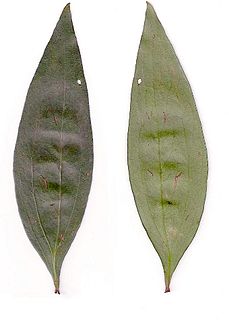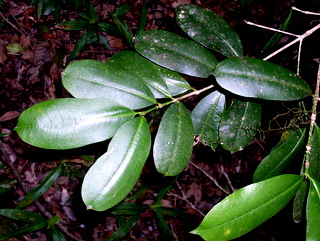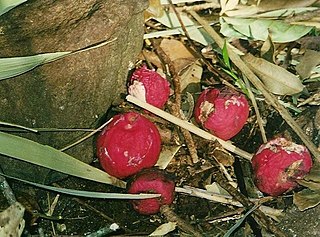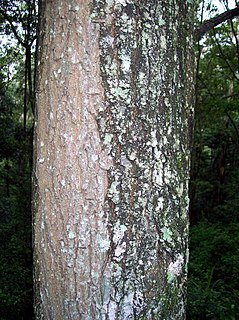
Alphitonia excelsa, commonly known as the red ash or soap tree, is a species of tree in the family Rhamnaceae. It is endemic to Australia, being found in New South Wales, Queensland, Northern Territory and the northeastern tip of Western Australia. It is used in bush regeneration as a pioneer species and for amenity planting.

Hibiscus splendens, the splendid hibiscus, is a species of flowering shrub or tree in the mallow family, Malvaceae. Other common names include hollyhock tree and pink cottonwood. H. splendens is a fairly common plant native to eastern Australia. The range of natural distribution is from Wollongong in the state of New South Wales to Blackdown Tableland National Park in central east Queensland. The habitat is on clearings or disturbances around the margins of the drier rainforests.

Gossia bidwillii, known as the python tree is a rainforest myrtle of eastern Australia. The usual habitat is the drier rainforest areas. The range of natural distribution is from the Hunter River in New South Wales to Coen in far northern Queensland.

Stenocarpus salignus, known as the scrub beefwood is an Australian rainforest tree in the family Proteaceae. Found in warmer rainforests on the coast and ranges. It is often found in warm temperate rainforest on poorer sedimentary soils, or on volcanic soils above 750 metres above sea level. It was originally described by the botanist Robert Brown in 1810.

Baloghia inophylla is a rainforest tree of eastern Australia. It is also known as the brush bloodwood, as it occurs in brushes,, as well as bloodwood, as the clear sap is blood red. Other common names include ivory birch and scrub bloodwood.

Acmena ingens is a rainforest tree of eastern Australia. It grows on volcanic soil from the Big Scrub region of north eastern New South Wales to Gympie in south eastern Queensland. Known as the red apple or southern satinash, Acmena ingens is one of many fleshy fruited myrtles in Australian rainforests, often referred to as lilli pillies.

Auranticarpa rhombifolia is a rainforest tree of eastern Australia. Known as the diamond leaf pittosporum, this tree is planted in many parts of Australia as an ornamental. The white flowers and orange fruit make it a most appealing street or garden tree. Other common names include hollywood, diamond leaf laurel, white myrtle and white holly.

Backhousia leptopetala is a common Australian tree, growing from Stanwell Park in the northern Illawarra district to near Buderim in south eastern Queensland.

Backhousia subargentea is a rare Australian rainforest tree, growing near Mullumbimby in north eastern New South Wales and from Boonah to Imbil in south eastern Queensland.

Atractocarpus benthamianus is a species of flowering plant in the family Rubiaceae growing in eastern Australia. It is an understorey species of subtropical and tropical rainforest on fertile soils. The natural range of distribution is from Forster, New South Wales to central Queensland. This plant features beautifully scented flowers.

Elattostachys nervosa, known as the green tamarind or beetroot tree is a common rainforest tree of eastern Australia. Found in all types of rainforest, growing from Paterson, New South Wales in the south to Gympie in south east Queensland. The name Elattostachys refers to "little spikes", a flower feature of other plants in this genus. Nervosa refers to the prominent leaf venation. Beetroot Tree refers to the beetroot red leaves of the new growth.

Bridelia exaltata, known as the brush ironbark or scrub ironbark, is a tree of eastern Australia. It occurs in and on the margins of the drier rainforests. Also occurring by streams, often in association with the Black Bean, up to an elevation of 600 metres above sea level. It occurs from Seal Rocks, New South Wales to Maryborough, Queensland.

Alchornea ilicifolia, commonly known as the native holly is a bush of eastern Australia. Growing in or on the edges of the drier rainforests, from Jamberoo, New South Wales to Atherton, Queensland.

Gossia acmenoides, known as the scrub ironwood, is a rainforest tree of the family Myrtaceae, native to eastern Australia. The usual habitat of this small tree is drier rainforest areas. The range of natural distribution is from Jamberoo in New South Wales to Eungella National Park in northern Queensland.

Pseudoweinmannia lachnocarpa is a rainforest tree of eastern Australia. Common names include rose marara, mararie, scrub rosewood and red carabeen. The species name lachnocarpa is from the Greek, referring to the "woolly fruit". The genus name refers to the similarity of another genus, Weinmannia, after the German eighteenth century pharmacist J.W. Weinmann.

Petalostigma triloculare, known as the long-leaved bitter bark is a rainforest tree of eastern Australia. It occurs in the drier rainforests, often on sandy soil derived from granite or sandstone, and is sometimes seen on old sand dunes.

Planchonella queenslandica, the blush condoo, is a large rainforest tree of the family Sapotaceae native to eastern Australia. It's found in sea side rainforest as well as the drier inland rainforests. From as far south as the Richmond River, New South Wales to Coen in tropical Queensland, and as far west as Melville Island, Northern Territory.

Pouteria eerwah is a rare species of Australian rainforest tree in the family Sapotaceae. Common names include shiny-leaved condoo, black plum and wild apple. It is endemic to south eastern Queensland, with a restricted distribution and regarded as endangered. There is discussion whether this plant should remain named as Planchonella eerwah.

Archidendron muellerianum, the Veiny Lace Flower, or Small-flower Laceflower is a rainforest tree with a restricted range in eastern Australia. It is a rare plant, with a ROTAP rating of 3RCa.

Gossia fragrantissima, the sweet myrtle or small-leaved myrtle, is a shrub or small tree of eastern Australia. A plant with a ROTAP rating of 3EC-, endangered by extinction. Found in sub tropical rainforests near streams, from near Woodburn, New South Wales to Nambour in south eastern Queensland. It features fragrant flowers, hence the specific epithet fragrantissima. White flowers grow from October to February.



















